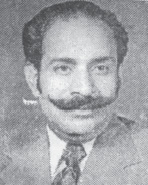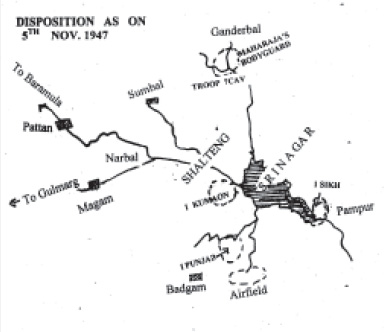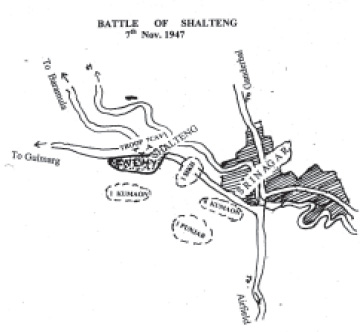Battle of Shalteng
How Srinagar was saved in 1947
By M. M. Munshi
 The division of the British administrated provinces as it
eventually took place was on the basis of political considerations. Certain
areas i. e Eastern part of
Bengal,
and western part of Punjab which were predominantly Muslim populated were
allotted to Pakistan, Sind and Baluchistan were allotted in Toto to
Pakistan.
A referendum was held in
NWF
Province, which opted for Pakistan. Khan Abdul Ghaffar Khan and his followers
boycotting the referendum as they like the congress party stood for secular
democracy and would have preferred to exercise the third option of
Independence
which was not given to them in the referendum. On the transfer of power by
British Paramountcy was retroceded from the king emperor to the 565 princely
ruled states who had never exercised external affairs, defense and
communications during the British rule. The biggest of the states exercised
absolute, the intermediaries wide but not absolute powers, the rest were estates
rather than states. Each of the 565 rulers was expected to accede to one of the
dominions according to his choice and not on the basis of religious beliefs of
the people of his state. Almost all the states acceded to either of the
dominions some with apparent reluctance except Junagarh,
Hyderabad
and Jammu & Kashmir. The stories of the accessions of Junagarh and Hyderabad
otherwise well known are beyond the scope of this article. The division of the British administrated provinces as it
eventually took place was on the basis of political considerations. Certain
areas i. e Eastern part of
Bengal,
and western part of Punjab which were predominantly Muslim populated were
allotted to Pakistan, Sind and Baluchistan were allotted in Toto to
Pakistan.
A referendum was held in
NWF
Province, which opted for Pakistan. Khan Abdul Ghaffar Khan and his followers
boycotting the referendum as they like the congress party stood for secular
democracy and would have preferred to exercise the third option of
Independence
which was not given to them in the referendum. On the transfer of power by
British Paramountcy was retroceded from the king emperor to the 565 princely
ruled states who had never exercised external affairs, defense and
communications during the British rule. The biggest of the states exercised
absolute, the intermediaries wide but not absolute powers, the rest were estates
rather than states. Each of the 565 rulers was expected to accede to one of the
dominions according to his choice and not on the basis of religious beliefs of
the people of his state. Almost all the states acceded to either of the
dominions some with apparent reluctance except Junagarh,
Hyderabad
and Jammu & Kashmir. The stories of the accessions of Junagarh and Hyderabad
otherwise well known are beyond the scope of this article.


Lacking support from any but a small section of the people of
Jammu &
Kashmir, Pakistan brought pressure on the Maharaja, cut off all supplies of
food, petrol, salt and other commodities on the import of which the State was
dependant. In order to exert further pressure a series of several raids were
made on the outposts of state forces in south western border of the state. Far
from heeding Maharaja’s protests Pakistan sent a tribal force from NWFP led by
regular Pakistani army officers proceeded towards Kashmir valley. On 22nd Oct
1947 it was joined by Mirpuri-Punchi deserters of the 4 J&K infantry at Domel,
the town of Muzzafrabad was ransacked and the tribal force advanced towards Uri-
Baramula.
The Maharaja finally realizing the situation evacuated Srinagar on
the night of 25.10.47 reaching Jammu on the morning of 26th and signed the
instrument of accession and Indian troops were flown from Delhi to Srinagar the
first batch of 3 rifle companies and battalion HQs of the 1st Sikhs under Col.
D. R. Rai landed at
Srinagar
on 27th morning at 9. 30 AM, further sub units of the 1st Sikh followed. With
almost whole of his whole battalion available for operations by afternoon Col
Rai after leaving a detachment of his command for the defense of the airfield he
moved with his main force towards Baramula in transport provided by civil
authorities and state forces head quarters. He thought that if he could reach
Baramula before the enemy he could deploy his unit on the hills south of
Baramula he could prevent the enemy from entering Baramula and proceeding
eastward into the Valley. After reaching outskirts of Baramula with one of his
platoon which he was leading from the front, his party was engaged by a medium
machine gun manned by deserters of 4 J&K Inf. His jeep was hit and he had to
beat a hasty retreat on foot along with the wounded when he was hit by medium
machine gun fire in the face and was killed along with the platoon commander. 1
Sikh now left without a commander retreated to Srinagar Airfield where they were
met by Major Sampuran Bachan Singh 2nd in command of the battalion who took over
command and led the battalion back to Patan. After taking a defensive position
and awaited the promised arrival of the enemy. But nothing like that happened
for probably the Pakistani commander of the tribal force was unsure of what lay
behind Patan defenses and avoided a frontal assault.. After a few days the
enemy started bypassing the Patan defences by fanning out in all directions all
over the valley. In the meantime it was decided to raise the strength of the
troops to a brigade level and as such the airlift of troops to
Srinagar
was continuing unabated. The brigade was designated as 161 Infantry Brigade and
Brig. J. C. Katoch [Later Maj-Gen and GOC Madras Area ] was appointed as its
commander who left for Srinagar by air on
29th Oct 47 along with then Col L. P. Sen D. S. O, Dy.
Director of Military Intelligence Army Hqs(Later Lt. Gen. and GOC Eastern
Command who had commanded 16 Battalion of the Baluch Regiment with
distinction as part of All India Brigade under Brigadier K. S. Thimayya (later
Chief of Staff, Indian Army ) during the 2nd World war in
Burma.
Brig Katoch was wounded and evacuated and L. P. Sen was appointed
as the new commander of 161 Brigade. He had at his disposal (i) 1 Sikh [
reinforced by additional Sikh companies detached from Infantry regiments and
gunners of a mountain battery allotted to
Pakistan. The
latter were organized as a rifle company ]. It was a very strong battalion of
about 1200 men commanded by Lt. Col. Sampuran Bachan Singh, (ii) 1st Bn Kumaon
Regt. A parachute battalion 650 in strength,commanded by
Lt.
Col. Pritam
Singh (Later Brigadier Pritam Singh-Hero of Punch }This unit and two rifle
companies of 4 Kumaon battalion were managing the defense of the airfield.
Brig. Sen made 1 Kumaon responsible alone for the defence of the airfield and
companies of 4 Kumaon were brought inside the perimeter of the airfield as
reserve. 1st Bn Punjab Regiment also a parachute battalion was under-strength
comprising about 450 men commanded by Lt. Col G. S. Khullar who were deployed on
the left flank of the 1st Sikh on Magam road. Major P. N. Kak of the state
forces who was assigned as liasion officer with 161 Brigade was instructed to
find out deployment availability of the State Forces particularly the infantry
at and around Srinagar. As per information collected by Maj. Kak there were no
troops of the state forces available except about 100 troopers of the Maharaja’s
bodyguard which was infact a ceremonial unit and had hardly any fighting value.
The troopers of the bodyguard were ordered to report to 161 Bde Hqs. located
near the airport which they promptly did. They were given a reconnaissance role
to proceed on trot in a westerly direction direction for three quarters of an
hour and then to retrace its steps with strict instructions to withdraw to the
airfield if enemy was encountered, and not to get involved in any fighting.
Immediately after the bodyguard left the Bde Commander moved with a small escort
to a Karewah hill to watch from a vantage point how the body guards operated. He
was surprised to see a mountain battery of Patiala State forces entrenched in a
gap between two Karewahs invisible from the main road. They had been ordered by
the J&K State forces Hqs to deploy themselves near the airfield, they had and
could not register any targets as the entire battery was without dial sights. Infact
at the request of Maharaja of J&K one infantry battalion and one mountaian
battery of the Patiala state forces been and an infantry battalion had been to
Kashmir valley ND jammu respectively by 12th Oct. The authorities at Patiala had
told their gunners that dial sights would be provided by J&K State forces,and
J&K state forces had expressed their inability to do so. In the meantime the
troopers of the bodyguard returned without encountering the enemy. They were
ordered to return to Srinagar and proceed next morning to Ganderbal and keep
watch on the northern approaches to Srinagar. With the object of patrolling the
western approaches of the airfield two rifle companies from 4l Kumaon under
Maj. Somnath Sharma moved towards Budgam and secured a base one rifle company
from 1 Kumaon under Capt. Wood moved west wards and after making contact with
!st Punjab
[Now 1st Guards ] at Magam returned to airfield via Srinagar without
enncountering the enemy by 1. 00 pm without meeting the enemy. Out of the two
companies of 4 Kumaon one withdrew by 2. 00 pm the other company was heavily
fired upon by the enemy from inside of houses and attacked by a very strong
force appearing from a depression between two karewas. Kumanis put up a
devastating fire and fought gallantly but being heavily outnumbered fell back
suffering many fatal casualties including Maj. Sharma, the enemy was apparently
making for the airfield and probably also wanted to enter Srinagar from the
south. The situation was saved by making air strikes on the enemy at Budgam and
shifting 1st Punjab from Magam to Hamhom to block the approach to airfield as
well as Budgam Srinagar road. Maj Somnath Sharma was awarded 1st Param Vir
Chakra the highest gallantry award of the Indian Armed forces posthumously.
The enemy was avoiding a frontal assault on 1st Sikh at Patan but
were on the move spreading in all directions in the valley. On 4th November
situation looked very grim with the limited troops i.e. less than three
battalions available with the 161 brigade it would have been very difficult to
tackle small parties of enemy infiltrating into
Srinagar
from many direction. Reinforcements in the shape of two full strength infantry
battalions, a squadron of armoured cars, a battery of field artillery together
with other supporting troops was expected to reach Srinagar by road on the
evening of 7th Nov. After giving due consideration to all pros and cons the
Brigade Commander decided to withdraw 1 Sikh from Patan to Srinagar and shifting
of 1st Punjab from Magam to Humhom to give the impression to the enemy that
after the action near Budgam on 3rd Nov. the brigade had taken a crippling
knock and was pulling its horns that would entice the tribal force to
assemble,regroup and rush in their motor transport towards Srinagar.
The gamble worked after the withdrawl of 1 Sikh on by 5th November
small partys of the enemy disappeared from the brigade front and reports poured
in that all parties of tribal raiders big and small were heading for Baramula.
It was planned that after the arrival of reinforcement s on 7th Nov. a wide
encircling maneuver by two infantry, battalions from airfield via Magam to
Patan and sandwich the enemy between Patan and
Srinagar, subject the tribal force to attacks
from the front and rear and annihilate it. It was expected that enemy attack on
Srinagar
defenses would materialize by 8th or latter, On 6th evening Major Inder Singh
Rikhe [Later Maj. Gen. and Commander of UN Force at Cyprus] of the 7th light
Cavalry with a troop of 4 armored cars and one rifle troop arrived at the
brigade headquarters as an advanced party of the reinforcement convoy and was
very much welcomed.. It was decided that out of the four cars a patrol of two
cars and the rifle troop under Lieut. Noel David would proceed as a
reconnaissance patrol via Ganderbal- Safapur road to Bandipur next day i. e 7th
Nov. by first light and after collecting all possible information from the
local police stations Maharaja's bodyguard and others return to airfield by the
evening.
Of the two battalions 1st Sikh was positioned west of
Srinagar at the
flood channel at Shalteng and 1st Kumaon in the rifle range (Chandmari) area.
After David with his armored cars and rifle troop left brigade headquarters
Commanding Officer of 1st Sikh informed Brigade headquarters on wireless that
his forward companies were heavily engaged by automatic fire including that from
medium machine guns. An immediate reconnaissance by air revealed that a force
of several thousand was present across the flood channel, about 150 vehicles
were parked on the road in the rear, but there was no moment on the road. The
situation which was planned for 10th presented itself to 161 Brigade on the
morning of 7th. Lieut. David’s patrol of armored cars and rifle troop was
diverted from Ganderbal via Krahom to Sumbal and ordered to proceed towards
junction of roads bifurcating for Baramula and Sumbal near Shalteng, and appear
in the rear of the enemy as if it was part of the enemy forces. It took about
20 minutes for the armored cars to cross a rickety wooden culvert near Karhom
which at first seemed to be impossible. After David reached the road junction
roads at Shalteng, 1st Sikh opened up with rapid fire,Davids armored cars and
rifle troop engaged the enemy from the rear 1st Kumaon burst on their right
flank with a bayonet charge. The stunned enemy was wondering as to what was
happening, there was complete confusion in its ranks. The tribal force with two
companies of deserters of 4th J&K infantry in order to escape the fire which was
hitting them from front, rear and right flank, rushed in all directions bumping
into one another turned and fled westwards. 1st Sikh was ordered to attack, the
armored cars and rifle troop in turn switched their fire west wards. The
fleeing enemy was harried with telling effect by strafing from air, which had
The battle of Shalteng was fought and won in less than half an hour and Srinagar
was saved from death and destruction that had befallen the towns of Muzzafrabad
and Baramula earlier. About 500 of the enemy were killed and another 150 lay
dead between Shalteng and Baramula. Patan was occupied same day by eight in
the evening and Baramula next day in the morningIt may not be out of place to
mention here that no sound of the firing was heard in the uptown and airfield
area probably due to thick mist and air currents blowing from east to west. In
spite of the fact that sounds of automatic fire and bursting of mortar shells
was clearly heard in the downtown area beyond the fifth bridge from wee hours of
the morning, the residents of Srinagar were unaware that enemy was at their
doorstep. Infact marriages were solemnized on the intervening night of 6/7
Nov. in
Srinagar
and in some houses mehandirat functions were going on. I as a resident of
downtown very vividly remember hearing the sound of firing of automatics,
bursting of shells and Chakri simultaneously. Some people who woke up at night
were assured by National Conference volunteers patrolling the city streets that
firing was from Indian army only to scare away any tribal forces which may have
reached outskirts of
Srinagar.
It was only after air force started strafing the fleeing enemy that people
climbed to upper storeys and roofs of their houses to watch the tiny Howard and
Spitfire fighters in action.
While paying homage to the brave officers and men of the 1st
battalions of Sikh and Kumaon Regiments together with two rifle companies of 4th
Kumoan Regiment troop of 7th Light Cavalry let us not forget their local
civilian Kashmiri drivers, guides, and informers especially those who along with
the soldiers sacrificed their lives and saved the day.
*(The author is a noted Researcher)
Source: Kashmir
Sentinel
| 